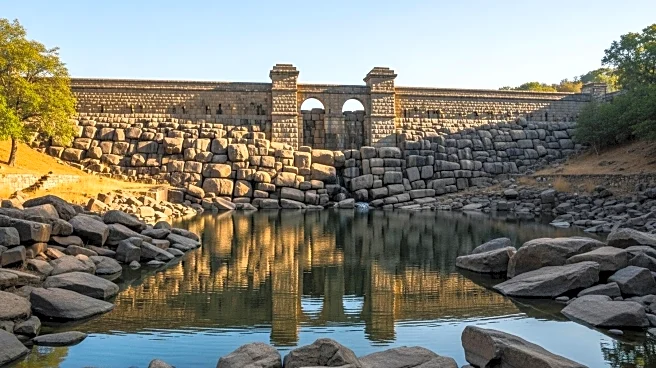What is the story about?
What's Happening?
Archaeologists have uncovered an ancient dam near the Pool of Siloam in Jerusalem's City of David, a site of significant biblical history. The discovery was made during excavations conducted by the Israel Antiquities Authority and the Weizmann Institute of Science. The dam, dating back to the 9th century B.C., is believed to have been constructed during the reign of either King Joash or King Amaziah. This structure is the largest and oldest dam found in Jerusalem, measuring approximately 39 feet high, 69 feet long, and 26 feet wide. The Pool of Siloam, rediscovered in 2004, is noted in the Gospel of John as the site where Jesus healed a blind man. The dam's construction is thought to have been a response to climate challenges, designed to collect water from the Gihon Spring and manage floodwaters in ancient Jerusalem.
Why It's Important?
The discovery of the ancient dam provides valuable insights into the engineering and environmental management practices of ancient Jerusalem. It highlights the historical significance of the region and its adaptation to climate conditions, such as droughts and flash floods. This finding not only enriches the understanding of Jerusalem's historical landscape but also underscores the city's continuous archaeological relevance. The dam's construction as a response to climate challenges reflects early human ingenuity in addressing environmental issues, a topic that resonates with contemporary global climate concerns. The excavation further cements Jerusalem's status as a site of profound historical and religious importance, attracting scholars and tourists alike.
What's Next?
Further archaeological investigations are likely to continue in the City of David, as researchers aim to uncover more about the ancient infrastructure and its role in the city's history. The findings may prompt additional studies into the environmental conditions of the period and how ancient societies adapted to them. The Israel Antiquities Authority and other research institutions may also explore the broader implications of such discoveries on understanding ancient urban planning and water management systems. These efforts could lead to new insights into the historical narratives of Jerusalem and its significance in biblical history.
Beyond the Headlines
The discovery of the dam near the Pool of Siloam adds a new dimension to the understanding of biblical sites and their historical contexts. It raises questions about the intersection of archaeology and religious narratives, offering a tangible connection to stories from the Bible. This finding may influence cultural tourism in Jerusalem, drawing visitors interested in both historical and religious aspects of the city. Additionally, it highlights the ethical considerations in preserving and studying ancient sites that hold religious significance for multiple faiths.
AI Generated Content
Do you find this article useful?














